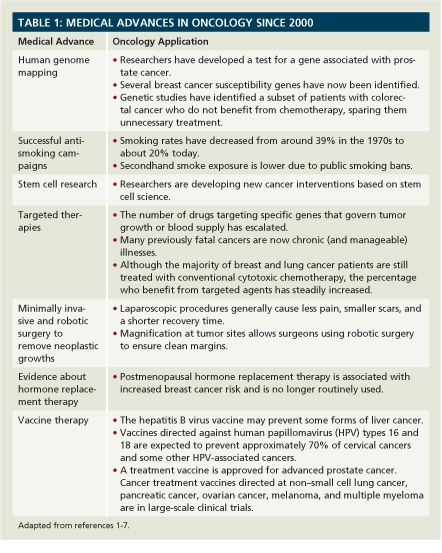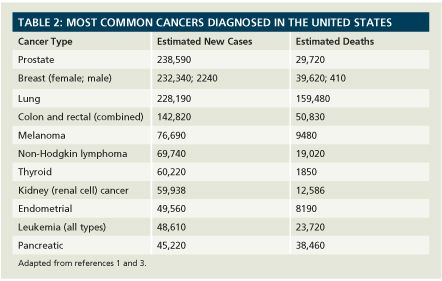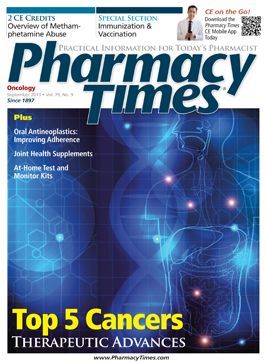Publication
Article
Pharmacy Times
Top 5 Cancers: Therapeutic Advances
Author(s):
Keeping up with advances in oncology is a welcome challenge.
Keeping up with advances in oncology is a welcome challenge.
Medical advances are built on change. Oncology has changed in leaps and bounds in the past few years (Table 1), building on medical advances that have benefited all areas of practice. Keeping up with the changes can be challenging for pharmacists, since it seems that there’s something new every day. Table 2 lists the cancers of most concern due to their prevalence. This discussion focuses on therapeutic advances for the top 5 cancers.
#1—Prostate cancer: Prostate cancer is the most commonly diagnosed cancer in the United States. The 5-year survival rate for affected patients is nearly 100%, up from 67% in the 1970s.3 Of the 10 FDA-approved drugs for prostate cancer, 7 were approved in the past 5 years: in 2008, degarelix (Firmagon); in 2010, cabazitaxel (Jevtana), denosumab (Prolia and Xgeva), and sipuleucel-T (Provenge); in 2011, abiraterone acetate (Zytiga); in 2012, enzalutamide (Xtandi); and just recently, radium 223 dichloride (Xofigo). Although degarelix, cabazitaxel, and enzalutamide are new drugs in old classes—gonadotropin-releasing hormones, toxoids, and antiandrogens, respectively—the others belong to promising new therapeutic classes:
- The monoclonal antibody denosumab addresses a serious concern related to prostate cancer, skeletal-related events.
- Sipuleucel-T is the first FDA-approved autologous cellular immunotherapy. It induces an immune response targeted against PAP, an antigen expressed in most prostate cancers.
- Radium 223 dichloride is a radiopharmaceutical that emits alpha particles that mimic calcium and form complexes with bone hydroxyapatite at areas of increased bone turnover, such as bone metastases; it destroys tumor cells but causes limited damage to surrounding normal tissue.
Insight: Note that various prostate cancer regimens have generally been considered equally effective and patients diagnosed with prostate cancer often receive long-term treatment.3 Clinician experience and patient preferences have played a large role in, and still influence, treatment selection. With new agents available, statisticians will be monitoring to see which treatments have the edge. Refer to the free National Comprehensive Cancer Network (NCCN) guidelines for the most current information about this and all cancers.8
#2—Breast cancer: In 1975, the only treatment considered for breast cancer was mastectomy, and the 5-year survival rate was 75%. With better screening techniques, an understanding of breast cancer’s subtypes, and a plethora of new treatment options, today’s 5-year survival rate is 90% and improving.2

Depending on the patient’s specific type of breast cancer (assessed using estrogen receptors, progesterone receptors, and human epidermal growth factor—receptor 2 profiling), combination therapies including lumpectomy, radiation, chemotherapy, and hormonal therapy can target treatment and eradicate cancer cells, even if they have spread beyond the breast. Treatment for several years with selective estrogen-receptor modulators (SERMs; tamoxifen or raloxifene) and aromatase inhibitors (anastrozole, exemestane, and letrozole) after surgery/radiation/chemotherapy decreases the likelihood of recurrence.8
Insight: In breast cancer, as in most other cancers, the tumor location, stage, metastatic status, and recurrence dictate treatment. Additionally, many women need long-term treatment with SERMs and aromatase inhibitors and often have questions about side effect management. This is an area in which community pharmacists can offer support to help patients manage side effects and remain on these preventive therapies.8
#3—Lung (non—small cell and small cell) cancer: Although lung cancer is #3 in terms of incidence, globally it’s the leading cause of cancer deaths and a pressing issue on our research agenda. It accounts for 15% of all cancer diagnoses but 29% of deaths.9 Five-year survival has improved very little—from 13% in 1975 to 16% today3,9—mainly because 70% of lung cancers are diagnosed at an inoperable or advanced stage.
Researchers have accrued significant advances in stereotactic ablative radiotherapy (the medical equivalent of a GPS system), which delivers radiation to tumors at very high doses in very small areas.10,11 Conventional radiation has also improved because targeted doses and careful shielding cause fewer complications. In chemotherapy, afatinib dimaleate (Gilotrif), crizotinib (Xalkori), erlotinib (Tarceva), and gefitinib (Iressa) have joined older and still-important chemotherapy. Note that they all end in “-inib,” indicating they target/inhibit tyrosine kinase pathways. Several of these can only be used in patients whose lung cancer has specific markers as detected by an FDA-approved test. Bevacizumab is approved for advanced nonsquamous non—small cell lung cancer in combination with carboplatin and paclitaxel in people who have not received chemotherapy for their advanced disease..5,9
Insight: Tobacco cessation is the best way to prevent lung cancer, and all experts advise working with lung cancer patients to help them stop smoking.3,12 For patients who cannot quit, the evidence-based guidelines “Diagnosis and Management of Lung Cancer, 3rd ed: American College of Chest Physicians Evidence-Based Clinical Practice Guidelines” recommends low-dose computed tomography scanning to screen people who have a significant lung cancer risk due to age and smoking history. Find the guidelines as a supplement to the May 2013 issue of CHEST.12-15
#4—Colorectal (colon and rectal) cancers: Colorectal cancer’s incidence and mortality have dropped significantly since the 1970s, and the 5-year survival rate has increased from 51% to 67%.3 Half of the change has been due to risk factor reduction, and half to heightened awareness and earlier intervention. Intravenous fluorouracil has been the cornerstone of treatment since the 1980s, with leucovorin added in the mid-1990s for patients with stage III colon cancer. Researchers then found that adding oxaliplatin improves outcomes and identified oral capecitabine as an alternative to 5-FU and leucovorin, moving treatment from the clinic to the community. For metastatic colorectal cancer, irinotecan is often used, as is radiation for tumors that can be radiated without injuring other organs in the gut.5,16
Treatment selection has been individualized to the patient’s specific condition and disease presentation. Since the turn of the century, the antiangiogenic bevacizumab (Avastin) has been approved for some patients with metastatic colorectal cancer, and the drug may extend survival. The targeted therapies cetuximab (Erbitux) and panitumumab (Vectibix) can extend survival or slow tumor growth, respectively, for some patients with advanced colorectal cancer.16
Insight: Chances of successful colorectal cancer treatment increase with earlier intervention. Encourage patients—especially those who have a family history of colorectal cancer—to undergo screening routinely. The free Centers for Disease Control and Prevention guidelines are available at www.cdc.gov/cancer/colorectal/basic_info/screening/guidelines.htm.17

Melanoma has been considered one of the most aggressive, treatment-resistant human cancers. Melanoma accounts for approximately 5% of all skin cancers but causes 3 times as many deaths each year as nonmelanoma skin cancers. Once rare, its incidence has increased dramatically as human exposure to solar ultraviolet radiation has increased. Genetics contribute to risk, and heritable risk factors include light complexion, an inability to tan, red hair, blue eyes, and familial atypical mole/melanoma syndrome. Traditionally, oncologists have used interferon alfa-2b, a drug with a difficult toxicity profile, in patients who have had lesions removed and have elevated recurrence risks.18
A change worth noting: in 2002, researchers discovered that more than half of melanoma occurs as the result of oncogenic BRAF mutations. Their findings—that BRAF mutations occur frequently in melanoma—suggested that inhibiting BRAF activity might be an effective treatment strategy. Identifying tumors that have BRAF mutations has led to 3 targeted treatments.18
Most oncologists currently use the oral alkylating agent temozolomide (Temodar) as the first-line drug for melanoma. The FDA also approved ipilimumab (Yervoy) in March 2011 for treating unresectable or metastatic melanoma. This drug is changing the landscape for melanoma patients; in its pivotal trials, it extended survival in patients who had run out of treatment options. In August 2011, vemurafenib (Zelboraf) was approved by the FDA for patients who have BRAF mutations.
It is expected to improve survival statistics positively. In addition, on May 29, 2013, the FDA approved trametinib (Mekinist) for treating unresectable or metastatic melanoma with a BRAF V600E or V600K mutation. Note that agents that target BRAF mutations can only be used if the patient’s biopsy sample shows these mutations on an FDA-approved test.18
Insight: The new drugs approved for melanoma aren’t perfect—they have serious side effect profiles; but they represent options for patients who previously had none. Despite the robust antitumor activity of these drugs, most patients have partial responses, and disease progression is typically seen at a median of 5 to 7 months.18
On the Horizon
It’s an exciting time for oncology. The National Cancer Institute and the National Human Genome Research Institute have partnered to create The Cancer Genome Atlas project (http://cancergenome.nih.gov/), which expects to create a library of genetic information on more than 20 cancers that affect adults. The project will use its growing knowledge to identify specific molecular changes that may be good drug targets or can be used to detect cancer earlier.
A similar project, Therapeutically Applicable Research to Generate Effective Treatments (http://target.cancer.gov), is attempting to identify molecular changes that lead to a variety of cancers that affect children.
Jeannette Y. Wick is a visiting professor at the University of Connecticut School of Pharmacy. She previously worked in the National Cancer Institute’s Pharmaceutical Management Branch.
Editor's Note: This article has been updated and corrected since it was first posted.
References
- National Cancer Institute. Common cancer types. www.cancer.gov/cancertopics/types/commoncancers. Accessed August 3, 2013.
- National Cancer Institute. Cancer advances in focus: breast cancer. www.cancer.gov/cancertopics/factsheet/cancer-advances-in-focus/breast. Accessed August 1, 2013.
- National Cancer Institute. Cancer advances in focus: cancer. www.cancer.gov/cancertopics/factsheet/cancer-advances-in-focus/cancer. Accessed August 1, 2013.
- Cox L. The top 10 medical advances of the decade. MedPage Today website. www.medpagetoday.com/InfectiousDisease/PublicHealth/17594. Accessed August 1, 2013.
- Joseph SO, Wu J, Muggia FM. Targeted therapy: its status and promise in selected solid tumors. Part II: Impact on selected tumor subsets, and areas of evolving integration. Oncology. 2012;26:1021-1030, 1035.
- Feucht C, VandenBussche H. Pharmacology update in adolescents: contraception and human papillomavirus vaccination. Adolesc Med State Art Rev. 2013;24:57-89, xi.
- Keenan B, Jaffee EM. Immunotherapy in preneoplastic disease: targeting early procarcinogenic inflammatory changes that lead to immune suppression and tumor tolerance. Ann N Y Acad Sci. 2013;1284:12-16.
- National Comprehensive Cancer Network. NCCN clinical practice guidelines in oncology. www.nccn.org/professionals/physician_gls/f_guidelines.asp. Accessed August 5, 2013.
- Katzel JA, Fanucchi MP, Li Z. Recent advances of novel targeted therapy in non-small cell lung cancer. J Hematol Oncol. 2009;2:2.
- Onishi H, Araki T. Stereotactic body radiation therapy for stage I non-small-cell lung cancer: a historical overview of clinical studies. Jpn J ClinOncol. 2013;43:345-350.
- Iyengar P, Timmerman RD. Stereotactic ablative radiotherapy for non-small cell lung cancer: rationale and outcomes. J Natl Compr Canc Netw. 2012;10:1514-1520.
- Leone FT, Evers-Casey S, Toll BA, Vachani A. Treatment of tobacco use in lung cancer: diagnosis and management of lung cancer. 3rd ed. American College of Chest Physicians evidence-based clinical practice guidelines. Chest. 2013;143(5 suppl):e61S-e77S.
- Advances in lung cancer treatment have major impact on short- and long-term outcomes. News-medical.net website. www.news-medical.net/news/20130508/Advances-in-lung-cancer-treatment-have-major-impact-on-short-and-long-term-outcomes.aspx?page=2. Accessed August 2, 2013.
- Gould MK, Donington J, Lynch WR, et al. Evaluation of individuals with pulmonary nodules: when is it lung cancer? diagnosis and management of lung cancer. 3rd ed. American College of Chest Physicians evidence-based clinical practice guidelines. Chest. 2013;143(5 suppl):e93S-e120S.
- Detterbeck FC, Mazzone PJ, Naidich DP, Bach PB. Screening for lung cancer: diagnosis and management of lung cancer. 3rd ed. American College of Chest Physicians evidence-based clinical practice guidelines. Chest. 2013;143(5 suppl):e78S-e92S.
- Heinemann V, Douillard JY, Ducreux M, Peeters M. Targeted therapy in metastatic colorectal cancer: an example of personalised medicine in action. Cancer Treat Rev. 2013;39:592-601.
- Centers for Disease Control and Prevention. Colorectal cancer screening guidelines. www.cdc.gov/cancer/colorectal/basic_info/screening/guidelines.htm. Accessed August 3, 2013.
- Jang S, Atkins MB. Which drug, and when, for patients with BRAF-mutant melanoma? Lancet Oncol. 2013;14:e60-e69.







